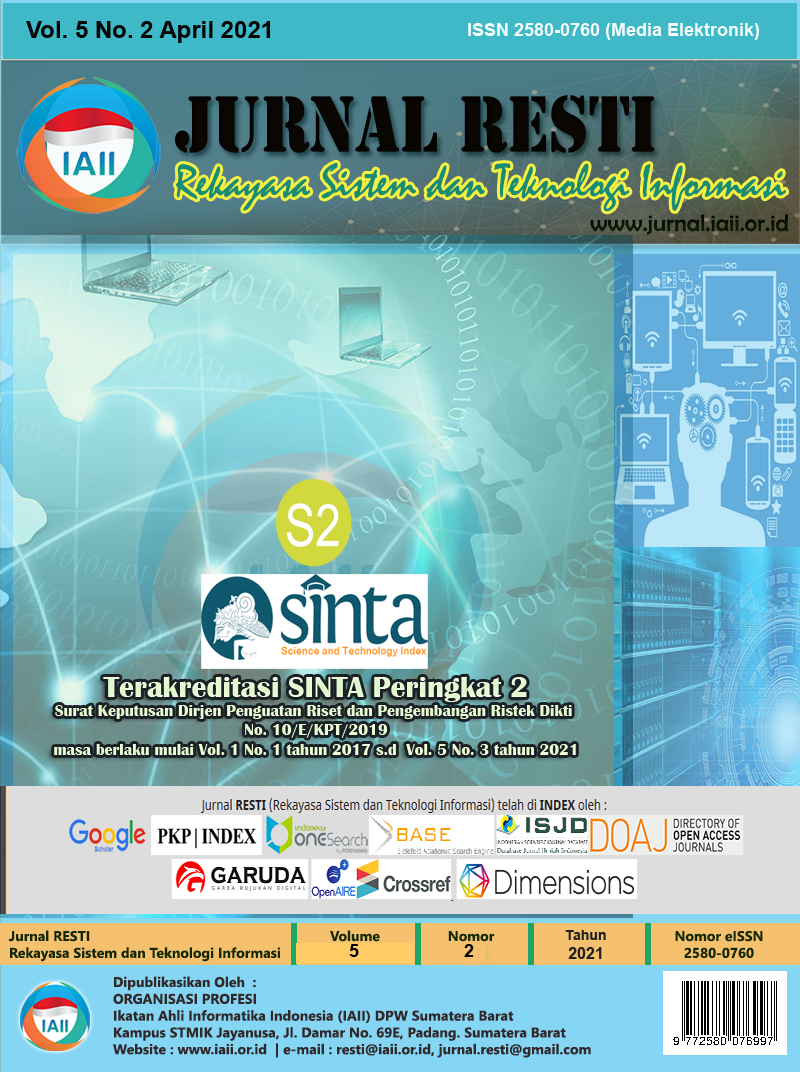Optimasi Akurasi Metode Convolutional Neural Network untuk Identifikasi Jenis Sampah
Abstract
Waste is goods / materials that have no value in the scope of production, where in some cases the waste is disposed of carelessly and can damage the environment. The Indonesian government in 2019 recorded waste reaching 66-67 million tons, which is higher than the previous year, which was 64 million tons. Waste is differentiated based on its type, namely organic and anorganic waste. In the field of computer science, the process of sensing the type waste can be done using a camera and the Convolutional Neural Networks (CNN) method, which is a type of neural network that works by receiving input in the form of images. The input will be trained using CNN architecture so that it will produce output that can recognize the object being inputted. This study optimizes the use of the CNN method to obtain accurate results in identifying types of waste. Optimization is done by adding several hyperparameters to the CNN architecture. By adding hyperparameters, the accuracy value is 91.2%. Meanwhile, if the hyperparameter is not used, the accuracy value is only 67.6%. There are three hyperparameters used to increase the accuracy value of the model. They are dropout, padding, and stride. 20% increase in dropout to increase training overfit. Whereas padding and stride are used to speed up the model training process.
Downloads
References
D. Hoornweg, P. Bhada-Tata, and C. Kennedy, “Environment: Waste production must peak this century.,” Nature, vol. 502, no. 7473, pp. 615–617, Oct. 2013, doi: 10.1038/502615a.
K. Fatmawati, E. Sabna, and Y. Irawan, “Rancang Bangun Tempat Sampah Pintar Menggunakan Sensor Jarak Berbasis Mikrokontroler Arduino,” Riau J. Comput. Sci., vol. 6, no. 2, pp. 124–134, 2020.
C. Chen, A. J. Barnett, and J. Su, “This Looks Like That : Deep Learning for Interpretable Image Recognition,” no. NeurIPS, pp. 1–12, 2019.
H. Yanagisawa, T. Yamashita, and H. Watanabe, “A study on object detection method from manga images using CNN,” in 2018 International Workshop on Advanced Image Technology (IWAIT), Jan. 2018, pp. 1–4, doi: 10.1109/IWAIT.2018.8369633.
R. Arandjelović, P. Gronat, A. Torii, T. Pajdla, and J. Sivic, “NetVLAD: CNN Architecture for Weakly Supervised Place Recognition,” IEEE Trans. Pattern Anal. Mach. Intell., vol. 40, no. 6, pp. 1437–1451, 2018, doi: 10.1109/TPAMI.2017.2711011.
J. Koushik, “Understanding Convolutional Neural Networks,” 2016, [Online]. Available: http://arxiv.org/abs/1605.09081.
Using Convolutional Neural Networks for Image Recognition. .
R. Sultana, R. D. Adams, Y. Yan, P. M. Yanik, and M. L. Tanaka, “Trash and Recycled Material Identification using Convolutional Neural Networks (CNN),” in 2020 SoutheastCon, 2020, pp. 1–8, doi: 10.1109/SoutheastCon44009.2020.9249739.
M. Yang and G. Thung, “Classification of Trash for Recyclability Status,” pp. 1–6.
Y. Kim, “Convolutional Neural Networks for Sentence Classification,” pp. 1746–1751, 2014.
D. Montserrat, Q. Lin, J. Allebach, and E. Delp, “Training Object Detection And Recognition CNN Models Using Data Augmentation,” Electron. imaging, vol. 2017, pp. 27–36, 2017
Copyright (c) 2021 Jurnal RESTI (Rekayasa Sistem dan Teknologi Informasi)

This work is licensed under a Creative Commons Attribution 4.0 International License.
Copyright in each article belongs to the author
- The author acknowledges that the RESTI Journal (System Engineering and Information Technology) is the first publisher to publish with a license Creative Commons Attribution 4.0 International License.
- Authors can enter writing separately, arrange the non-exclusive distribution of manuscripts that have been published in this journal into other versions (eg sent to the author's institutional repository, publication in a book, etc.), by acknowledging that the manuscript has been published for the first time in the RESTI (Rekayasa Sistem dan Teknologi Informasi) journal ;








